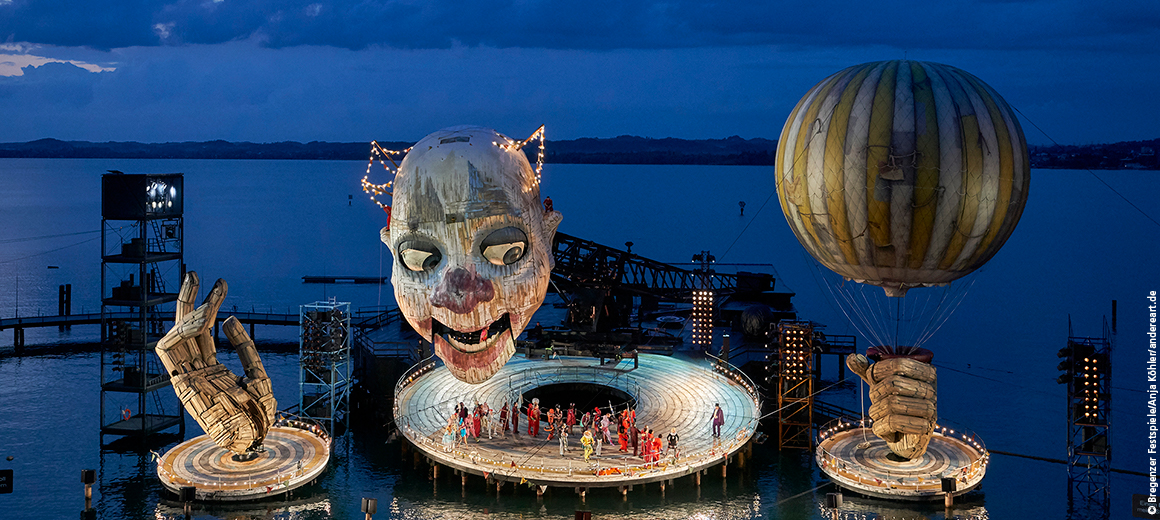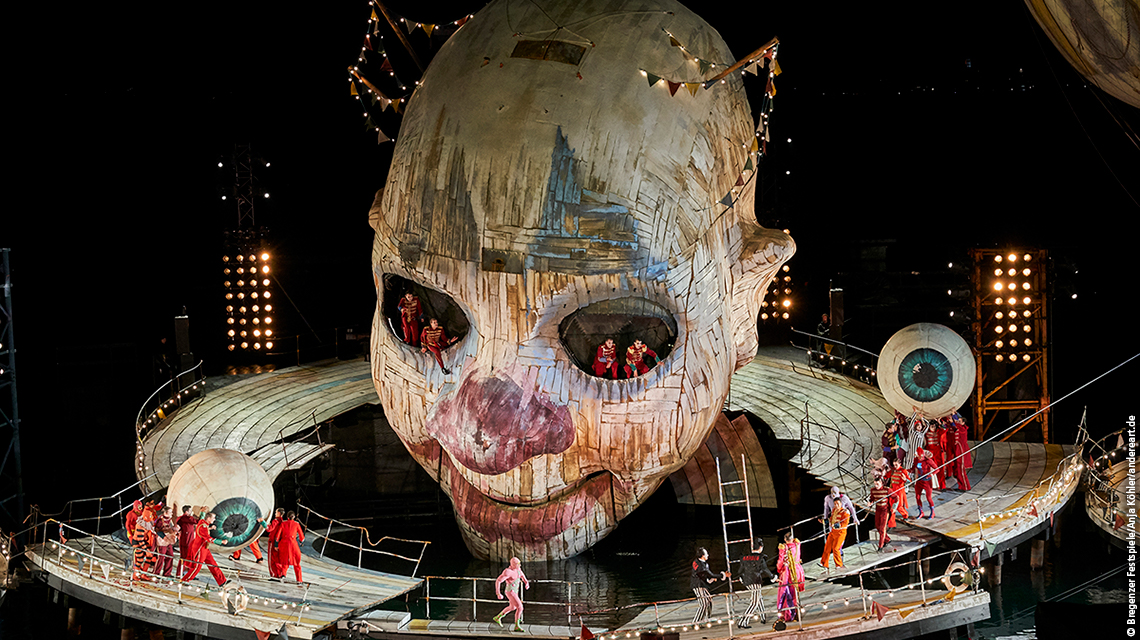

Breathtaking spectacle on Bregenz’s floating stage requires complex drive technology
The Bregenz Festival (Bregenzer Festspiele) on Lake Constance proved once again with an enthralling stage spectacle that audiences still love great opera, even in the 21st century. During the five-week 2019 season, roughly 180,000 spectators came to see Giuseppe Verdi’s “Rigoletto.” And the upcoming season, which will have its premiere on July 22, 2021, is almost completely sold out as well. An oversized clown figure – a kind of alter ego of Rigoletto – functions as the stage. To handle its complex movements, the Bregenz Festival depends on control technology from Beckhoff.
The “Seebühne Bregenz” (Bregenz floating stage) is famous for its spectacular productions, but Philipp Stölzl’s staging exceeds all past performances in terms of aesthetics as well as technical feasibility. It is therefore no wonder that it was awarded the German Stage Award, the Opus, and that steelworking company Biedenkapp received the German Metalworking Award 2019 in the Special Designs category. All in all, 46 companies were involved in building the stage, which required three years of planning and 14 months of actual construction time before the spectacle had its premiere on July 17, 2019.

Moving scenery plays a role in itself
In Stölzl’s production, the original location of the opera – the court of the Duke of Mantua – becomes a circus tent, and the court jester Rigoletto becomes a clown. The backdrop signifies that the protagonist is literally up to his neck in deep water. Only the head, encircled by a wide collar, and the hands of the gigantic clown protrude from the lake. He dominates the action and reflects the mental state of the opera’s tragic character that gives the opera its name. When Rigoletto enters the stage, the head awakens and smiles over a glittering feast. The actors bustle about on the figure’s collar, on its head, and in its mouth. The duke is a notorious seducer of women, and Rigoletto is his influential assistant. But when the duke seduces Rigoletto’s daughter Gilda, the tables are turned, and the clown becomes himself the victim of intrigues. As a visible symbol of his breakdown, the stage comes apart: the collar sections drift apart, and the eyes and nose fall out of the head. Instead of the smiling clown face, a gruesome skull now dominates the scenery.
Each movement is programmed
All movements of the stage and actions of the singers, the choir, the stuntpeople and the extras were programmed in advance in a digital 3D model by splitting the production into single cues, each of which can be called up with a unique command. “After the scenery had been installed on the floating stage in May 2019, we began to program each cue in accordance with the previous model to test the settings of the axes and the hydraulic controllers, and to subject each of them to a safety analysis with regard to their drive force, load and speed,” explains Wolfgang Urstadt, the technical director of the Bregenz Festival.
Demanding motion control
With a diameter of 22 meters (72 feet) and a total area of 338 square meters (3,638 square feet), the collar forms the central stage area. It consists of one fixed and three movable parts, which run on a system of rails driven by electric cable winches when the stage breaks apart.
Five hydraulic cylinders and 14 electric motors alone handle the various movements of the head, which is 13.5 meters (44 feet) tall and weighs 35 tons (about 77,000 pounds). Mounted on a rotating seesaw that is 35 meters (115 feet) long, the head can be moved across the stage with a 94-degree angle. Driven by a central hydraulic cylinder, the seesaw also makes it possible to raise the head or submerge it in Lake Constance until the water reaches its upper lip. “This is no easy feat,” says the stage technology manager: “Moving the head in only 27 seconds from 14.5 degrees above the horizon to 28 degrees below the horizon requires a hydraulic pressure of up to 160 bar.” Nodding motions are executed with two hydraulic cylinders moving at 4.4 degrees per second. And opening the lower jaw takes another two hydraulic cylinders moving at a speed of 10 degrees per second. Four electric motors shake the head, and eight more roll its eyes and open and close its eyelids. “That’s 19 axes for the head alone that must be controlled,” explains Andreas Bechter, systems integrator at STB Steuerungstechnik Beck GmbH in Andelsbruch, Austria. “The power ratings range from 2 to 22 kilowatts for the electric drives and from 75 to 90 kilowatts for the hydraulic pumps.”
The left hand, which reaches 11.5 meters (38 feet) out of the water and takes on various functions in the production, has a total of eight hydraulically driven axes. The biggest drive rotates the hand, while smaller drives connected in parallel tilt the hand. Small motors control the movements of the individual finger joints.

PC-based control technology speeds up complex implementation
“In terms of control technology, the challenge involved making the stage manageable because it was divided into so many individual moving parts. The complexity and the size of the stage and the absolute on-time delivery, which was a must considering the short season, were difficult to implement with traditional stage technology providers. That’s why we looked for alternatives and ultimately found Beckhoff,” says Wolfgang Urstadt. Each individual machine is equipped by its manufacturer with a simple commissioning controller. To communicate seamlessly with the higher-level Unican controller, a CAN-bus interface had been specified. The client also required various measurement systems for functions such as position feedback, encoder monitoring and pressure monitoring.
The redundant axis computers from Neuss-based stage technology specialist Unican control a total of 29 axes. Two control consoles are used to program and trigger the motion commands. From here, the axis movements are calculated and the commands issued to the underlying Beckhoff controller. Although the entire sequence is defined in detail, the performances do not run in automatic mode. As the stage manager issues the commands, one operator is responsible for controlling all head and collar movements and another operator controls the complex movements of the left hand. “Unforeseen events such as a strong wind gust can cause individual cues to be interrupted. Safety comes first,” says the technical director.
Unlike with stationary stages, the short season of the production and the predictability of any downtime that may occur require merely a project-based safety inspection. “The TÜV (note by translators: German technical inspection association) conducted the safety inspection as part of a prototype examination. This made it easier to keep to our tight schedule, because we could not begin rehearsals on the floating stage until the inspection had been completed,” explains Stefan Fritschke, the control technician of the Bregenz floating stage.

Decentralized control architecture meets the special requirements of the floating stage
From Stefan Fritschke’s point of view, the great advantage of the Beckhoff control system lies in its diversity of interfaces and its ability to operate with a decentralized control architecture. “The cramped space on the floating stage does not have room for a large control cabinet of the type you usually find in opera houses. That’s why we needed a decentralized control concept for the many distributed axes. We now have a main cabinet, which is linked to one cabinet for controlling the collar and a second one for controlling the head. In addition, the emergency controls were not designed as a large secondary controller, as is common in large opera houses. If the Unican controller issues an emergency signal, the local Beckhoff controllers for the various stage components move the stage machinery into a safe position,” says Andreas Bechter. “This was a special feature that we could only execute with Beckhoff. In case of a power failure, we perform a manual or emergency motion sequence.”
The control platform in the main cabinet is a CX5120 Embedded PC in combination with a 15-inch CP6602 built-in Panel PC. The control functions are executed with TwinCAT 3 automation software. The algorithms for the precise control and positioning of the hydraulic axes come from the TwinCAT Hydraulic Positioning software library. The fast communication system is EtherCAT, which stands out with its excellent diagnostic capabilities and easy configurability. The hydraulics control console is equipped with another CP6602 Panel PC. “In view of the extremely limited space on the stage, the compact design of the HD (high density) EtherCAT Terminals comes in handy. They feature 8 or 16 connection points in the housing of a 12-millimeter terminal block,” says STB general manager Alfred Beck.